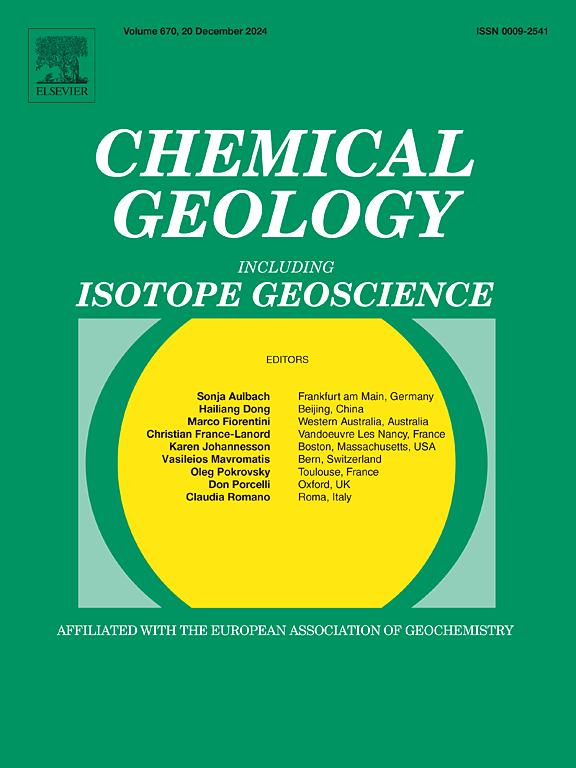Isotopically heavy sulfur in nephelinite from Etinde, Cameroon Volcanic Line: Implications for the origin of intraplate magmatism
IF 3.6
2区 地球科学
Q1 GEOCHEMISTRY & GEOPHYSICS
引用次数: 0
Abstract
Intraplate magmatism has traditionally been linked to anomalously hot mantle (hotspots) transported upwards from deep-sourced mantle plumes. However, many intraplate magmatic provinces lack convincing evidence for a mantle-plume origin, and the Cameroon Volcanic Line (CVL) located on the West African continental margin is one such province. Despite being active for ca. 65 million years, it lacks the time-progressive volcanic activity that would suggest the presence of a fixed mantle hotspot or plume; instead CVL magmatism has been linked to a shallow, enriched asthenospheric source. Etinde, a relatively young (<1 Ma) volcano located at the centre of the CVL on the continent-ocean boundary, is the most silica-undersaturated and incompatible element-enriched volcano in the region and forms the focus of this study. It is constructed almost entirely of feldspar-free nephelinite lava flows, with compositions ranging from olivine nephelinite to felsic leucite nephelinite. We report new sulfide-, sulfate- and bulk-δ34S data for a suite of Etinde rock samples; the first sulfur-isotope data for the CVL. Strong (∼8 ‰) S-isotope fractionation between sulfide and sulfate (haüyne, nosean) phases suggest equilibration temperatures of ∼600 °C, well below the magma solidus temperature and likely due to sub-solidus exsolution of nanoscale sulfide particles from the sulfate phenocryst phases. The most mafic samples from Etinde have been extensively degassed, containing less than 60 ppm sulfur, and therefore cannot be used to constrain the primary δ34S. Instead, we use the intermediate and felsic volcanic rocks, where sulfur is locked in phenocrysts of haüyne and nosean, respectively. Bulk δ34S of these rocks, which best represents the primary magmatic values, ranges from +3.7 ‰ to +6.3 ‰, a heavier signature than previously reported in alkaline igneous rocks. We propose that the heavy sulfur isotope values, together with the extreme silica undersaturation and incompatible element concentrations, reflect enrichment of the mantle source and fingerprint carbonate metasomatism in the mantle beneath the CVL. The heavy sulfur isotopic signature requires low-temperature fractionation and therefore implies the addition of sulfur through subduction processes. Our study has broad geochemical significance in contributing to a growing understanding of sulfur-isotope compositional variability in geochemically enriched mantle globally.
喀麦隆火山线埃廷德霞石中的同位素重硫:对板块内岩浆活动起源的影响
传统上,板块内岩浆活动与异常热地幔(热点)从深源地幔柱向上输送有关。然而,许多板块内岩浆省缺乏地幔柱起源的令人信服的证据,位于西非大陆边缘的喀麦隆火山线(CVL)就是这样一个省。尽管活跃了大约6500万年,但它缺乏随时间推移的火山活动,这表明存在固定的地幔热点或羽流;相反,CVL岩浆活动与一个浅的、富集的软流圈源有关。Etinde火山是一个相对年轻(<1 Ma)的火山,位于大陆-海洋边界的CVL中心,是该地区硅不饱和和不相容元素富集的火山,是本研究的重点。它几乎完全由不含长石的钠云石熔岩流构成,成分从橄榄石钠云石到长英质亮晶石钠云石不等。我们报告了一套Etinde岩石样品的新的硫化物、硫酸盐和块状δ 34s数据;CVL的第一个硫同位素数据。硫化物和硫酸盐(ha yne, nosean)相之间的强(~ 8‰)s同位素分馏表明,平衡温度为~ 600℃,远低于岩浆固相温度,可能是由于硫酸盐斑晶相中纳米级硫化物颗粒的亚固相析出。来自Etinde的大多数基性样品已被广泛脱气,含硫低于60 ppm,因此不能用于限制初级δ34S。相反,我们使用了中间和长英质火山岩,其中硫分别被锁在ha yne和nosean的斑晶中。这些岩石的δ34S值在+3.7‰~ +6.3‰之间,比以往报道的碱性火成岩的δ34S值更重,最能代表原生岩浆值。我们认为,重硫同位素值、硅元素的极度欠饱和和不相容浓度反映了地幔源的富集和指纹碳酸盐交代作用。重硫同位素特征需要低温分馏,因此表明硫是通过俯冲过程加入的。我们的研究具有广泛的地球化学意义,有助于加深对全球地球化学富集地幔硫同位素组成变化的认识。
本文章由计算机程序翻译,如有差异,请以英文原文为准。
求助全文
约1分钟内获得全文
求助全文
来源期刊

Chemical Geology
地学-地球化学与地球物理
CiteScore
7.20
自引率
10.30%
发文量
374
审稿时长
3.6 months
期刊介绍:
Chemical Geology is an international journal that publishes original research papers on isotopic and elemental geochemistry, geochronology and cosmochemistry.
The Journal focuses on chemical processes in igneous, metamorphic, and sedimentary petrology, low- and high-temperature aqueous solutions, biogeochemistry, the environment and cosmochemistry.
Papers that are field, experimentally, or computationally based are appropriate if they are of broad international interest. The Journal generally does not publish papers that are primarily of regional or local interest, or which are primarily focused on remediation and applied geochemistry.
The Journal also welcomes innovative papers dealing with significant analytical advances that are of wide interest in the community and extend significantly beyond the scope of what would be included in the methods section of a standard research paper.
 求助内容:
求助内容: 应助结果提醒方式:
应助结果提醒方式:


